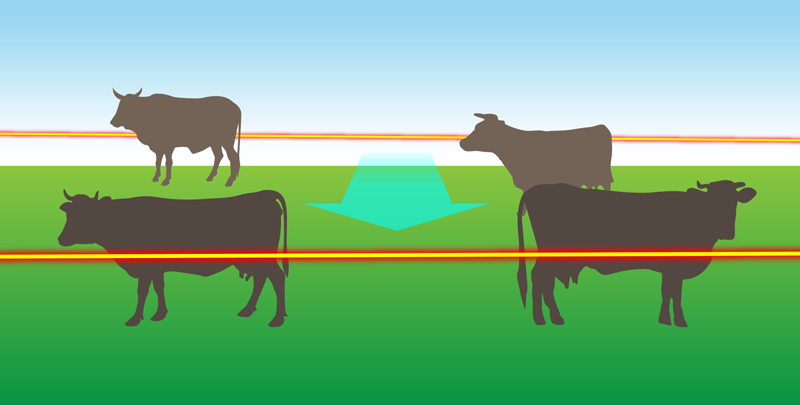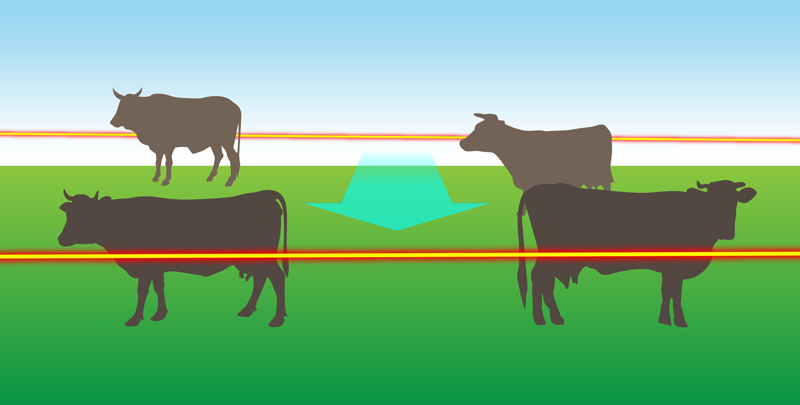Combing a Herd for Methane Emissions
Animal farms are believed to produce about the same amount of greenhouse gas as cars. They also generate harmful pollutants like ammonia. New farming strategies could help reduce animal emissions, but assessing their effectiveness is tricky because the emissions are typically too small to be precisely measured in real time. At the virtual Conference on Lasers and Electro-Optics (CLEO) in May, Daniel Herman of the National Institute of Standards and Technology (NIST) and the University of Colorado Boulder reported a possible solution. In a proof-of-principle test with a small cattle herd, he and his collaborators showed that frequency combs—laser sources that enable exceptionally precise fundamental-physics measurements—can detect the herd’s trace emissions.
Cows, and other farm animals, produce gas as they digest food and through their manure. These gases include methane and nitrous oxide—molecules whose global warming potential far exceeds that of carbon dioxide. Researchers are exploring how changes in animal diet, in pasture soil, and in “manure management” could reduce these emissions. But the resulting shifts in gas concentration are generally too tiny to measure, except when the cows are packed together, for example, in a feedlot before being slaughtered.
To make detection more sensitive, Herman, who collaborated with researchers at Kansas State University, turned to one of precision spectroscopy’s most sophisticated tools, the frequency comb. Like many spectroscopic techniques, frequency combs track the presence of specific molecules by revealing their spectral “fingerprints”— absorption lines whose frequencies correspond to molecular vibrations or rotations. In conventional spectroscopy, these absorption lines are derived from the attenuation of infrared light. This light can come from a stable, coherent laser beam, which yields great frequency resolution but can’t easily be tuned over a broad frequency range; or it can come from an incoherent lamp, which has a broad spectrum but lacks the resolution and coherence of lasers.
“Laser combs give you the best of both worlds,” probing vast spectral ranges with coherent light, Herman says. The version of the technique that he and his collaborators used, called dual-comb spectroscopy, involves two infrared laser combs. Each comb’s spectrum is made up of hundreds of thousands of discrete frequency peaks, or “teeth,” that span the relevant spectra of methane, water, carbon dioxide, nitrous oxide, and ammonia. Crucially, the two combs have slightly different tooth spacings. After passing through a sample that partially absorbs them, the combs are made to interfere at a detector. The resulting signal contains beat amplitudes at microwave frequencies, and a frequency analysis of these amplitudes reveals the sample absorption spectrum.
A few years ago, another group used frequency comb spectroscopy to help detect carbon dioxide, methane, and other emissions from urban and industrial sources. In experiments completed last January, Herman and his colleagues showed that the technique works for monitoring livestock emissions too.
The researchers set up on a trailer beside a soccer-field-sized feedlot in Manhattan, Kansas. Using lasers built at NIST and some optical components, they produced two dual combs. One dual comb traveled back and forth through the air along the north side of the lot; the other dual comb traveled back and forth along the south side of the lot. Analyzing the dual combs on the truck, the team determined the gas content along the lot’s two sides. Comparing the two combs and accounting for the effect of wind flow (the fact that one comb was downstream and the other upstream), they found the cow’s contribution to various gas emissions. These measurements were sensitive enough to pick up methane, water, carbon dioxide, and ammonia that clearly came from animal activity—for instance, the amounts of these gases peaked a couple of hours after the cows ate.
The researchers detected methane at less than one part per million concentrations—comparable to state-of-the-art techniques used for livestock emission monitoring. But Herman says that their setup’s sensitivity could be easily improved by using better optics and combs at midinfrared wavelengths, where molecules have stronger absorption lines. With such upgrades, they should be able to monitor herds that, compared to the one in Kansas, are more spread out and representative of typical cattle pastures.
Herman says frequency combs might work for more than livestock monitoring, such as tracking the gases released by crops. “Gases like ammonia are indicators of soil health and monitoring them could help farmers make smarter, science-based decisions,” Herman says. But to achieve these lofty goals, he says that researchers now need to work on making these “agrophotonics” technologies sufficiently cheap, rugged, and easy to use.
Correction (2 July 2020): Two links to previous frequency comb work were updated to better distinguish between work that was done with methane and with carbon dioxide.
–Matteo Rini
Matteo Rini is the Editor of Physics Magazine.





